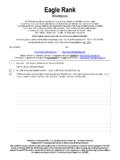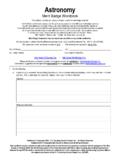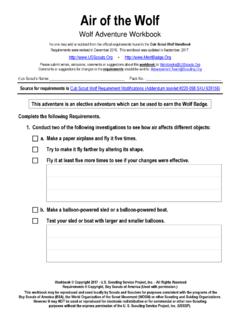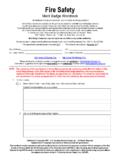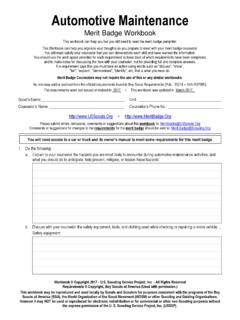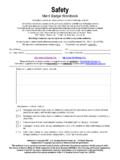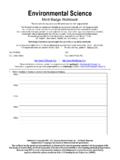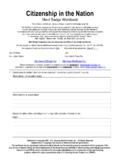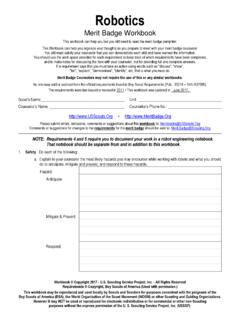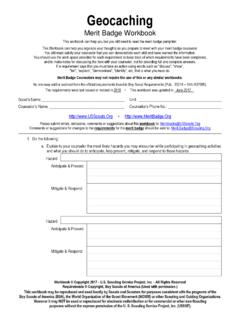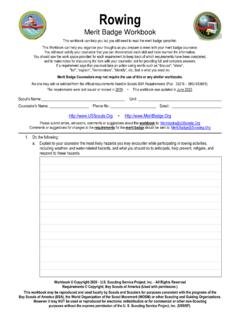Transcription of Lifesaving - Us Scouting Service Project Inc
1 Lifesaving Merit Badge Workbook This workbook can help you but you still need to read the merit badge pamphlet. This Workbook can help you organize your thoughts as you prepare to meet with your merit badge counselor. You still must satisfy your counselor that you can demonstrate each skill and have learned the information. You should use the work space provided for each requirement to keep track of which requirements have been completed, and to make notes for discussing the item with your counselor, not for providing full and complete answers. If a requirement says that you must take an action using words such as "discuss", "show", "tell", "explain", "demonstrate", "identify", etc, that is what you must do.
2 Merit Badge Counselors may not require the use of this or any similar one may add or subtract from the official requirements found in Boy scout Requirements (Pub. 33216 SKU 637685). The requirements were last issued or revised in 2017 This workbook was updated in June 2017. scout s Name: _____ Unit: _____ Counselor s Name: _____ Counselor s Phone No.: _____ Workbook Copyright 2017 - Scouting Service Project , Inc. - All Rights Reserved Requirements Copyright, Boy Scouts of America (Used with permission.) This workbook may be reproduced and used locally by Scouting volunteers for training purposes consistent with the programs of the Boy Scouts of America (BSA), the World Organization of the scout Movement (WOSM) or other Scouting and Guiding Organizations.
3 However it may NOT be used or reproduced for electronic redistribution or for commercial or other non- Scouting purposes without the express permission of the U. S. Scouting Service Project , Inc. (USSSP). submit errors, omissions, comments or suggestions about this workbook to: or suggestions for changes to the requirements for the merit badge should be sent to: 1. Before doing requirements 2 through17: a. Complete Second Class rank requirements 5a through 5d and First Class rank requirements 6a, 6b, and 6e. Second Class rank requirements 5a through 5d 5a. Tell what precautions must be taken for a safe swim.
4 5b. Demonstrate your ability to pass the BSA Beginner test. Jump feetfirst into water over your head in depth, level off and swim 25 feet on the surface, stop, turn sharply, resume swimming, then return to your starting place. 5c. Demonstrate water rescue methods by reaching with your arm or leg, by reaching with a suitable object, and by throwing lines and why swimming rescues should not be attempted when a reaching or throwing rescue is possible Lifesaving scout 's Name: _____ Lifesaving - Merit Badge Workbook Page. 2 of 10 5d. Explain why and how a rescue swimmer should avoid contact with the victim.
5 First Class rank requirements 6a, 6b, and 6e 6a Successfully complete the BSA swimmer test: Jump feet first into water over your head in depth, swim 75 yards in a strong manner using one or more of the following strokes: sidestroke, breaststroke, trudgen, or crawl; then swim 25 yards using an easy, resting backstroke. The 100 yards must be swum continuously and include at least one sharp turn. After completing the swim, rest by floating. 6b Tell what precautions should be taken for a safe trip afloat.. 6e With a helper and a practice victim, show a line rescue both as tender and as rescuer.
6 (The practice victim should be approximately 30 feet from shore in deep water.) b. Swim continuously for 400 yards using each of the following strokes in a strong manner, in good form withrhythmic breathing for at least 50 continuous yards: front crawl, sidestroke, breaststroke, and elementary backstroke. 2. Discuss and review with your counselor the principles of BSA Safe Swim Defense. Lifesaving scout 's Name: _____ Lifesaving - Merit Badge Workbook Page. 3 of 10 3. Explain the following: a. Common drowning situations and how to prevent them. b. How to identify persons in the water who need assistance.
7 C. The order of methods in water rescue. d. How rescue techniques vary depending on the setting and the condition of the person needing assistance. e. Situations for which in-water rescues should not be undertaken. Lifesaving scout 's Name: _____ Lifesaving - Merit Badge Workbook Page. 4 of 10 4. Demonstrate "reaching" rescues using various items such as arm, leg, towels, shirts, paddles, and poles. Arms Legs Towels Shirts Paddles Poles 5. Demonstrate "throwing" rescues using various items such as a line, ring buoy, rescue bag, and free-floating support. Successfully place at least one such aid within reach of a practice victim 25 feet from shore.
8 Lines Ring Buoys Rescue Bags Free-Floating Supports 6. Show or explain the use of rowboats, canoes, and other small craft in performing rescues. 6. With your counselor's approval, view in-person or on video a rowing rescue performed using a rowboat, canoe, kayak, or stand up paddleboard. Discuss with your counselor how effectively and efficiently the rescue was performed. 7. List various items that can be used as aids in a go rescue. Explain why buoyant aids are preferred. 8. Correctly demonstrate rescues for a conscious practice subject 30 feet from shore in deep water using two types of buoyant aids provided by your counselor.
9 Use a proper entry and a strong approach stroke. Speak to the subject to determine his condition and to provide instructions and encouragement. a. Present one aid to a subject, release it, and swim at a safe distance as the subject moves to safety. b. In a separate rescue, present the other aid to a subject and use it to tow the victim to safety. 9. Discuss with your counselor when it is appropriate to remove heavy clothing before attempting a swimming rescue. Lifesaving scout 's Name: _____ Lifesaving - Merit Badge Workbook Page. 5 of 10 Remove street clothes in 20 seconds or less, enter the water, and approach a conscious practice subject 30 feet from shore in deep water.
10 Speak to the subject and use a nonbuoyant aid, such as a shirt or towel, to tow the subject to safety. 10. Discuss with your counselor the importance of avoiding contact with an active subject and demonstrate lead-and-wait techniques. 11. Perform the following non-equipment rescues for a conscious practice subject 30 feet from shore. Begin in the water from a position near the subject. Speak to the subject to determine his condition and to provide instructions and encouragement. a. Perform an armpit tow for a calm responsive, tired swimmer resting with a back float. b Perform a cross-chest carry for an exhausted responsive subject treading water.
